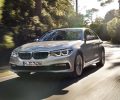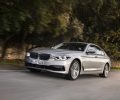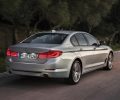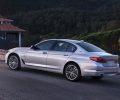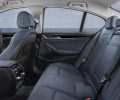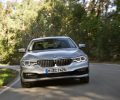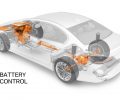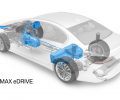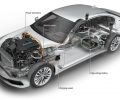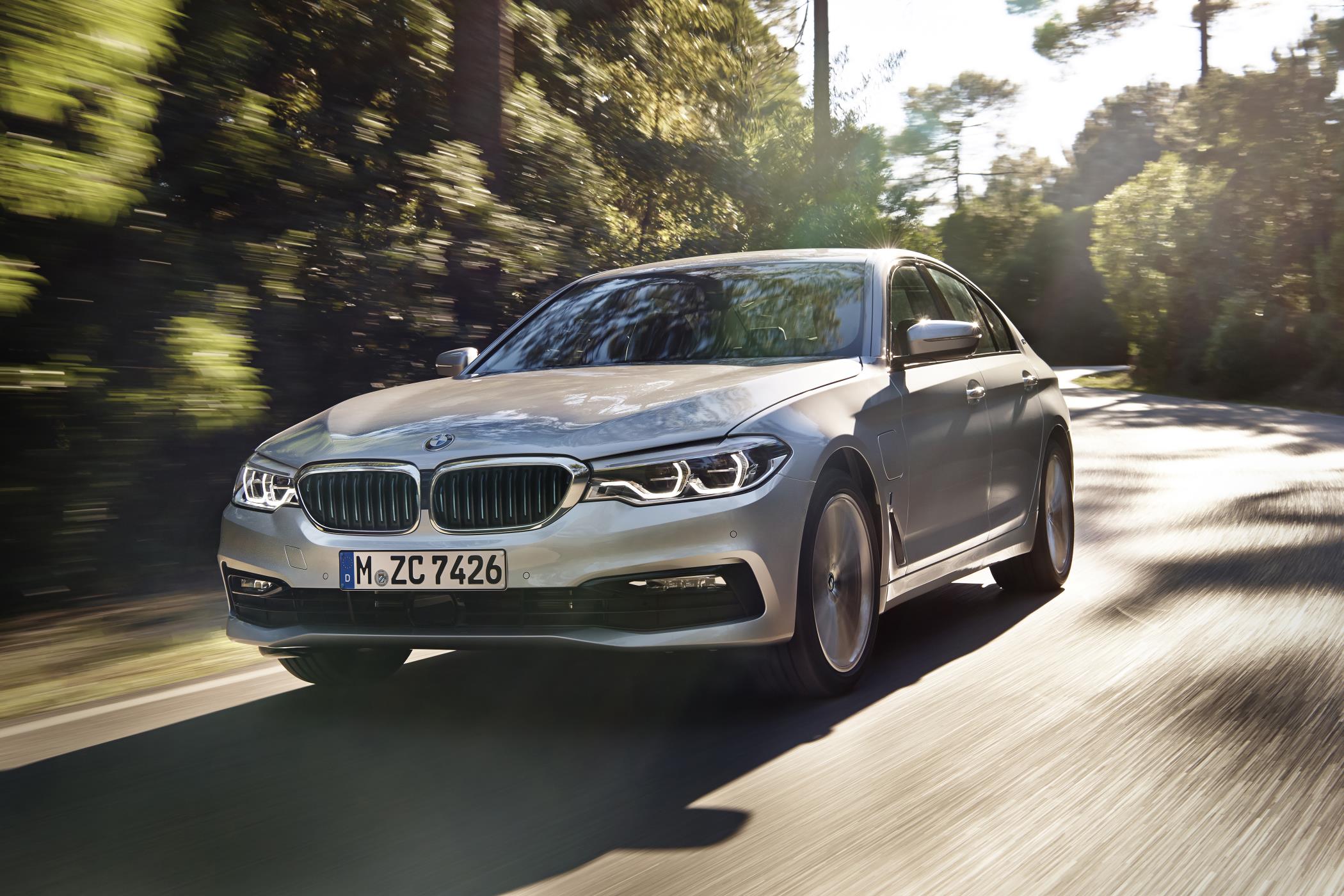
- First BMW iPerformance model to be offered in both sDrive Rear-wheel drive and xDrive All-wheel drive.
- Fourth member of the growing BMW iPerformance model lineup bearing testimony to the BMW i know-how transfer.
- Featuring the full wealth of driver assistant systems and latest innovations derived from the all-new BMW 5 Series.
Woodcliff Lake, NJ – December 17, 2016 5:45 pm EST / 2:45 pm PST …
Today, BMW announces the latest addition to its iPerformance line-up, the first ever BMW 530e iPerformance. The BMW 530e iPerformance is a sport sedan that serves up the dynamic driving experience for which the brand is renowned, combined with the option of electric driving. The BMW 530e iPerformance offers the full breath of BMW 5 Series Advanced Driver Assistance systems and the latest technology just premiered in the all-new BMW 5 Series, now with eDrive plug-in hybrid powertrain technology. As for its power source, trailblazing BMW eDrive technology teams up with a BMW TwinPower Turbo gasoline engine to create an exceptionally efficient and powerful plug-in hybrid drive system that fits perfectly with the dynamic, smooth and luxurious character profile of the new BMW 5 Series. The iPerformance badge attached to all of BMW’s plug-in hybrid models bear testimony to the transfer of engineering excellence from BMW i. In the U.S., the BMW 530e iPerformance is the fourth member of a growing portfolio of iPerformance models already available at U.S. dealers.
The 2018 BMW 5 Series iPerformance will be available at U.S. dealers in spring 2017. Pricing will be announced closer to market launch.
Power delivery on all electric.
The BMW eDrive system’s electric motor has an output of 95 hp and offers maximum torque of 184 lb-ft on tap, while the 4-cylinder TwinPower Turbo combustion engine with its 2.0-liter displacement generates 180 hp and 215 lb-ft of torque (preliminary). The overall system output of 248hp (preliminary) and combined peak torque of 310 lb-ft (preliminary) propel the BMW 530e iPerformance from 0 to 60 mph in 6.1 seconds (preliminary) and enable it to reach a top speed of 130 mph (preliminary). The electric motor and combustion engine direct their power to the sedan’s rear wheels in the BMW 530i Sedan or all four wheels in the BMW 530i xDrive sedan via the standard 8-speed Steptronic transmission with paddle shifters. Positioning the electric motor upstream from the transmission allows the transmission’s ratios to be used in all-electric mode too. This dispenses with the need for a torque converter, something that goes a long way towards offsetting the weight penalty of the additional drive unit.
The high-voltage battery pack consisting of lithium-ion cells with a total capacity of 9.2 kWh has been placed in a space-saving location underneath the rear seat and includes efficient refrigerant cooling with a highly integrated low-temperature circuit. Thanks to the battery’s installation, the BMW 530e iPerformance offers full use of the trunk and a flat load compartment floor. The battery can be charged to full capacity in under 7 hours from a residential 120V outlet using the OUC (Occasional Use Cable), while tailor-made solutions enabling safe, straightforward charging are available through BMW 360° Electric Lifestyle, such as the BMW Installation Services and BMW Solar Energy programs. The BMW Charging Station uses its output of 3.6kW – 7.2 kW (16/32 A, 240 V) to reduce charging time to under three hours, to wake up to a fully charged vehicle each day. The progress of the charging process can be tracked via a graphic in the car’s instrument cluster.
iPerformance Characteristics.
BMW 530e iPerformance is equipped with various elements unique to the iPerformance line-up. Exterior design elements include: blue kidney grille slats, blue wheel hub covers, charging socket located between the front wheel arch and the A-pillar on the driver’s side, “i” badging on the front fenders, “eDrive” emblems on the C‑pillars and the “530e” badge on the trunk lid. When passengers open the doors they are welcomed by illuminated door sills bearing the “eDrive” lettering. The BMW 530e iPerformance also comes with an eDrive button on the center console, along with specially designed displays for both the instrument cluster in front of the driver and the central information screen.
BMW eDrive.
As well as the Driving Dynamics Control switch, with its SPORT, COMFORT and ECO PRO settings. The eDrive button, unique to the iPerformance models offers three driving modes: AUTO eDRIVE, MAX eDRIVE and BATTERY CONTROL.
AUTO eDRIVE ensures that the engine and electric motor interact to optimum effect in all driving situations and allows an all-electric top speed of 56 mph (preliminary). This mode is automatically activated as the default setting every time the vehicle is started. When MAX eDRIVE mode is selected, the BMW 530e iPerformance drives on electric power alone. To do so, it uses the electric drive’s full power and can attain a maximum speed of 87 mph. However, if the accelerator is pressed through to kick down the engine will kick in which is whenever an extra boost of power is needed.
BATTERY CONTROL mode lets the driver set the charge level for the high-voltage battery manually. The intelligent battery management of the BMW 530e iPerformance either keeps the high-voltage battery’s charge constant at the selected level or increases it to the pre-set value, with the electric motor acting as a generator. BATTERY CONTROL mode makes it possible to conserve or even increase the reserves of electric power while traveling on the highway to ensure that an upcoming section through an urban area can be driven on pure electric.
Latest-generation iDrive for even more intuitive operation.
As in all the other models in the new BMW 5 Series line-up, the navigation, telephone, entertainment and vehicle functions grouped within the standard high-resolution 10.25-inch iDrive display can be controlled not only using the iDrive Controller, but also by the iDrive Touch screen display or with the help of the Intelligent Voice Assistant. Optional BMW Gesture Control which offers a particularly intuitive and easy way of operating commonly used infotainment system and telephone functions allows the driver and passenger another convenient way of interacting with iDrive 6.0.
Driver Assistance Systems.
The new BMW 530e iPerformance comes with an extensive range of assistance systems which can be used in conjunction of eDrive mode. Utilizing the Blond Spot Detection system when switching lanes, Active Lane Keeping Assistant with Side Collision Avoidance steers the vehicle back into its lane if the sensors detect another vehicle in the lane. Two systems, providing a semi-automated driving capability are Active Lane Keeping Assistant & Traffic Jam Assistant. Together, these systems operate between 0 – 130 mph and use smooth, comfort-enhancing steering interventions to keep the vehicle in lane. The latest generation of the system features improved image recognition and software algorithms to keep the vehicle reliably on course. In certain situations, particularly in stop & go traffic, the system also uses the vehicle in front as an additional reference point.
Active Cruise Control with Stop & Go for all driving situations .
Dynamic Cruise Control (DCC), which is standard on the BMW 5 Series Sedan, maintains any selected speed between 19 –130mph. It also supports energy-saving coasting by decoupling the engine from the powertrain when the driver lifts off the accelerator at higher speeds. The new and improved Active Cruise Control (ACC) with Stop & Go uses radar to adjust the pre-selected speed to the traffic situation. The system operates at all speeds up to 130 mph and is capable of braking to a standstill in stop & go traffic and automatically senses if the vehicle in front is moving once more. If the vehicle has been placed into standby mode by pushing the resume button on the steering wheel, the all-new BMW 5 Series can automatically start moving again up to 30 seconds after coming to a full-stop. The ACC system now also takes into account highway exits and traffic circles where it adjusts the acceleration dynamics to suit these special traffic situations. The control technology monitors two vehicles ahead so that vehicle speed can be adjusted earlier and smoother. Heating elements ensure that the front-mounted radar sensor remains fully operational even if it’s snowing.
Active Lane Departure Warning.
The Lane Departure Warning system operates at speeds between 40 – 130 mph. If the forward-facing stereo camera detects that the vehicle is straying from its lane, Active Lane Keeping Assistant helps the driver steer back on course with smooth and seamless steering interventions. Utilizing the Active Blind Spot Detection system (12-130 mph) when switching lanes, Active Lane Keeping Assistant with Side Collision Avoidance steers the vehicle back into its lane if its sensors detect another vehicle in the next lane. Side Collision Avoidance, which operates at speeds between 40 and 130 mph, warns drivers by means of a visual signal or steering wheel vibration if another vehicle has drifted too close to the side of the vehicle. If the system detects sufficient room on the other side of the vehicle, it correctively steers the vehicle in this direction and out of a possible accident. This corrective steering assistance can be overridden at any time by the driver.
Evasion Aid: evasive steering around obstacles.
Another new function contained with Active Driving Assistant Plus is the Evasion Aid. If a quick lane change is required, for example when the vehicle in front brakes aggressively, the evasion aid – which operates at speeds up to 100 mph – supports the necessary evasive steering action. Faster steering and counter steering during an evasive maneuver results in reduced vehicle instability, supported by Dynamic Stability Control (DSC). While executing the maneuver, the Evasion Aid also uses information from the vehicle’s sensor systems to check how much unobstructed space is available around the vehicle. At speeds over 100 mph, the system no longer provides actual steering support and instead focuses on maximizing vehicle stability.
BMW Connected Onboard.
With the launch of BMW Connected in the USA and Europe in 2016, BMW has introduced an all-encompassing digital concept designed to aid personal mobility. Using the flexible Open Mobility Cloud as a basis, BMW Connected seamlessly integrates the vehicle into the user’s digital life via multiple touchpoints, such as an iPhone, Apple Watch, Android smartphone or smartwatch. New additions, introduced in the new BMW 5 Series Sedan, include BMW Connected Onboard, which allows personal information such as the next navigation destination, estimated arrival time and current weather conditions at the destination to be shown on the car’s display. BMW Connected is also able to transfer the user’s personal mobility agenda from their smartphone straight to their car.
3D Surround View.
Surround View and Remote 3D View offer peace of mind by allowing owners monitor their BMW 5 Series at all times. The system shows a bird’s-eye view of the driver’s car as well as a three-dimensional image of the area surrounding the vehicle. Any obstacles, including curbs, or other vehicles or pedestrians that suddenly appear can be spotted.
ParkNow and On-Street Parking Information.
The integration of the ParkNow service means that on-street parking spaces and garages can be easily located, reserved and paid for. Reservations can either be made while en route from the navigation system or in advance via the ParkNow smartphone app or website. Over 150 parking garages are currently affiliated with the ParkNow network in the U.S. alone, with that number expected to grow to over 500 affiliated garages by mid-2017. Once the selection has been made via the navigation system, the driver is directed straight to the chosen parking place and an electronic ticket is generated which grants access to the reserved space. On-Street Parking Information (OSPI) is receiving its world premiere in the all-new BMW 5 Series Sedan. This cutting-edge technology helps to alleviate the problem of vehicles searching for a parking space, which accounts for a large part of traffic congestion in metropolitan areas. OSPI works similar to the Advanced Real Time Traffic Information system, using historical and current data to draw conclusions regarding the availability of parking spaces on route within the coverage area. The system then uses a model to predict the odds of finding an open parking spot. A color coding on the navigation map displays the systems suggestions.

